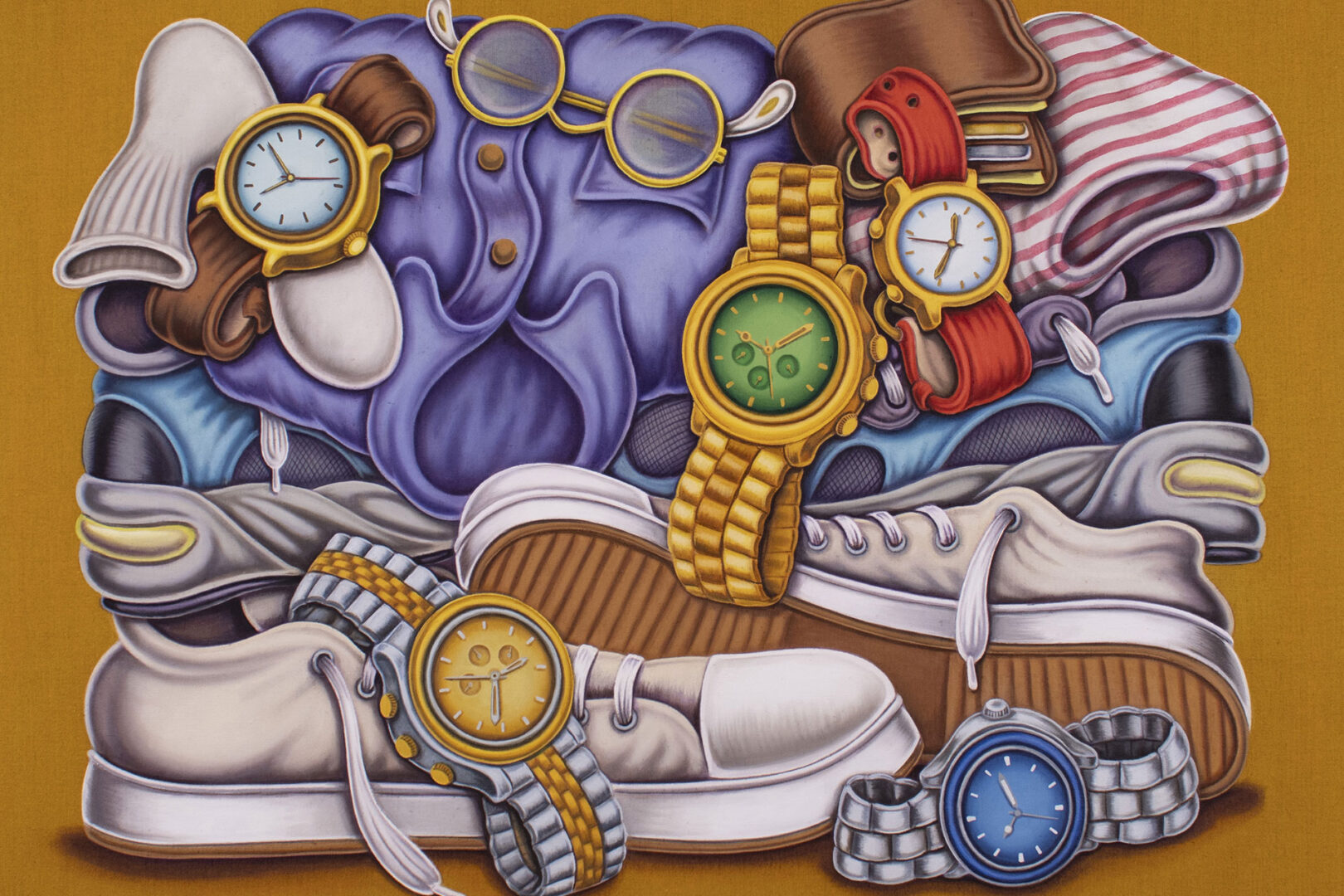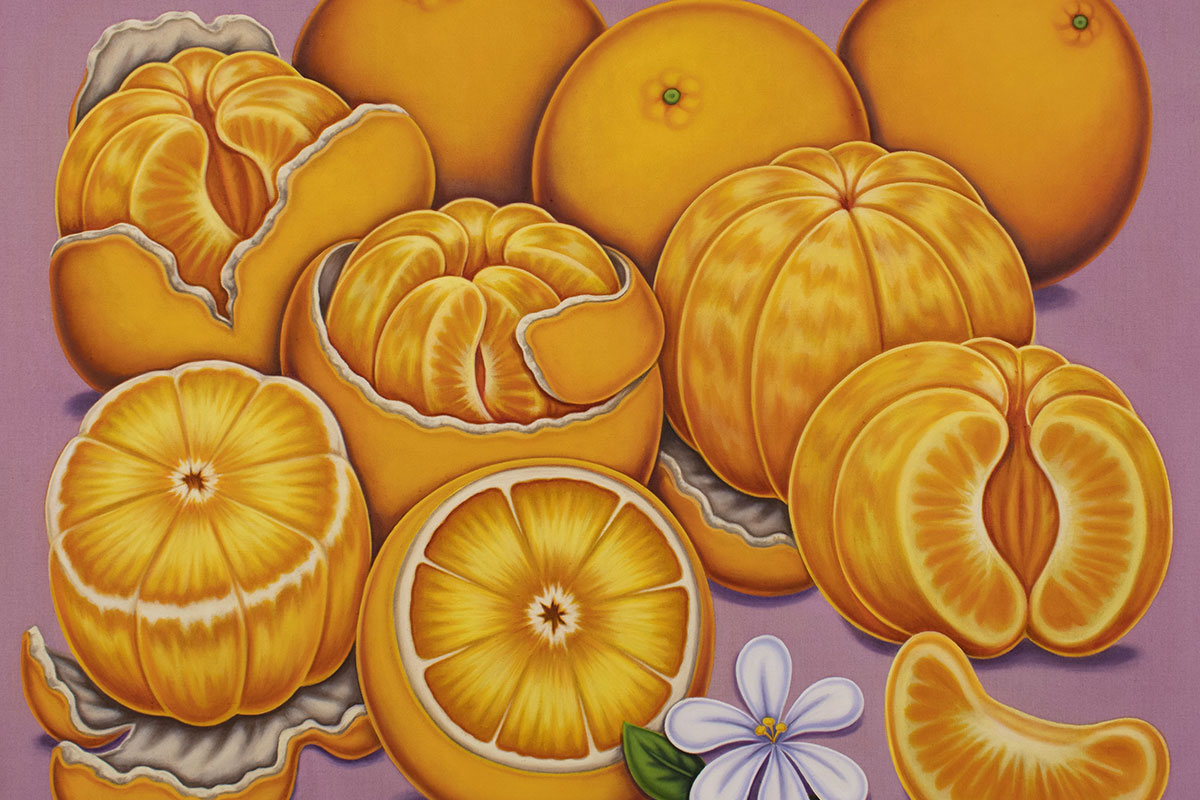«Online everything becomes flat, which is how many people consume art today and I think my paintings work well seen via the digital». Bringing back the still life for digital consumption
From spending two weeks in a hospital bed post emergency surgery to moving to the other side of the country, Pedro Pedro’s works have reflected each event through medium and style choices of subject matter. Pedro delves into the disorganized attraction of strewn garments, a half eaten meal, a melon cut open with the knife still present, immortalizing them within a still life painting: all proof of human movement and interaction with everyday objects within one captured moment. The artist plays with banality by highlighting the objects’ colors and forms, inviting the viewer to observe the composition as a reminder to mindfully take in the materials and objects around us, found amongst the chaos.
Pedro embodies the laid-back artist, at ease with the discord and unpredictable art world found in New York and Los Angeles. Having moved to the West Coast six years ago, his style and subject matter have mellowed in sync to his relaxed, more suburban surroundings.
Growing up around paint
After dropping out of college in his hometown in Florida, Pedro viewed New York as an opportunity to immerse himself within the dynamic hub of an urban setting, with access to art and its makers. «I’m from Florida originally, New York seemed the next proper step. I moved there when I was nineteen, and lived there until I was twenty-nine, so all of my formative years were spent there. Painting and making art always amused me, but I didn’t know that it was a thing. I grew up in a small town, I didn’t know that art was something you could do.
Whilst in high school, I took an art class and I started doing watercolors, one after another. I was doing faces, and anything that was pouring out of me. From that moment on, I knew that I wanted to continue with art. I stopped doing everything else and fully concentrated on art. My dad is a house painter, and through him I would be offered to add a mural to someone’s home. I started to earn money this way at sixteen. Since I grew up painting houses with my father, one of my first jobs was cleaning the brushes after use. I grew up around paint. It became a way for me to communicate with other people, which is still the case today, because it is something I struggle with».
New York, the art school
Pedro’s new urban settings presented itself as a form of informal art education. Observing, taking in the surroundings and learning by doing and making; Pedro soaked in his new environment, gradually improving his figurative style and painting skills.
«I dropped out of college in Florida, I was attending a school called Ringling College of Art and Design, in Sarasota, at the time. I decided to move to New York with a friend, who had a six month art residency. After which I ended up moving into an art gallery warehouse space which I found on Craigslist, even though it had an awful description, I went to check it out. There was art everywhere, high sculptures, in one room there was a huge hand, big enough to lay on and there were spikes coming out of it and pig hearts hanging from the ceiling. I felt at home instantly. I was looking for a community, especially as I was only twenty years old».
Through the art gallery/warehouse space Pedro came into contact with a variety of artists, gallerists and creatives. «One of the first people I met at the warehouse was the artist Judith Supine (real name Brendan Fagan), who was working on a couple of collages, which he was posting around New York at the time. I had assumed that the artist had been a woman because of the name, but actually it’s his art/mum’s name».
Pedro began to contribute to his surroundings with odd jobs, assisting with collages, preparation of exhibition spaces, theater sets and costumes. «I worked for a fabric painter, who was painting costumes for Alvin Ailey Dance Company, all for the theater. I was painting directly onto silk, using a dye mixed with a thickener, which almost became a paint».
Medical malpractice
At the age of twenty Pedro experienced medical malpractice, which would not only motivate his move to the other side of the country and offer new prospects in the long run, but also leave a large impact on his artistic research and the pieces being produced.
«I moved from New York to Los Angeles because I won a lawsuit, after I lost one of my testicles. When I was twenty years old I went to two doctors because of a swollen testicle, I was prescribed antibiotics, five days later I went to the hospital and they told me that I should have gone to them sooner ‘We need to cut this thing out tomorrow!’. I stayed in the hospital for two weeks after the operation.
During this time I began painting on the bedsheets, it was a whole experience. I left the hospital and my friends advised me to see a lawyer. Seven years later, I’m in court having to explain everything in front of a judge and jury. There’s a blown up picture of my testicle next to me. I win the lawsuit and go home with $100,000, which I used to fund my move. I’m almost gambling on myself and seeing what’s happening».
Moving into textile
Prior to his stay in the hospital, Pedro hadn’t had much luck with opportunities to exhibit his works other than in his living space. Having started to experiment with a different ‘canvas’ Pedro’s works evolved into the medium he still practices today: the application of textile paint onto unprimed linen.
«Today I am working with paints that have that similar tactile quality. Similar to when I was painting on the bedsheets in the hospital. After I left the hospital, I went looking for a material that had similar qualities. A material that was thin, where the paint would soak in. That’s how I began to do these larger scroll works».
The impact of the operation itself also influenced Pedro’s style and subject matter, moving into disfigured bodies, missing or extra limbs, even a relatively dark quality.«I made my first contacts in New York, I was mainly showing my works in the space I was living in. They wouldn’t give me a show for a while, but after I got out of the hospital they gave me my first show because I started pouring out paintings.
Before my time in the hospital, my works were a little more rough, almost childlike, cruder, child-esque – my mother is a first grade teacher, perhaps inspired by childhood art. When I was drawing in the hospital with a pen and watercolor, it worked for me, I fully immersed myself in this new style. I did ten, twelve works immediately, and then the gallery was interested in organizing a show together, from there other people became interested. It was mostly figurative at this point, deformed bodies. After losing the testicle, there was definitely a personal element to these works, I think that I was trying to understand the change to my body».
East Coast to West Coast
After ten years immersed in the city and chaos of New York, Pedro moved to Los Angeles in search of a different lifestyle and opportunities as an artist.
«My work became lighter, also in terms of subject matter. Less figures, more objects. That’s where it changed, with the move to Los Angeles. I decided to isolate myself. I had the lawsuit money, I was able to focus, not having to work for anybody else.
As a result, I could concentrate on making paintings and figuring out who I am. So it slowly evolved into these still lifes. Since two years ago, I haven’t painted a figure. I had an idea to have two figures at a table, merging figures into my still life theme, but I am undecided on if it will actually work how I want it.
I feel like using figures says too much, and I love doing figures. But I want it to have the same feel as the still life, I want to keep it as banal as possible, such as a bowl of fruit. It’s difficult, as there’s automatically a narration when figures are introduced. Whereas with a bowl of oranges, which you can say a lot but at the same time say very little, people can find what they want or simply see oranges».
From real life to still life
Pedro’s still lifes have an instant bounce, they are exaggerated forms of everyday objects, of the banal, of what we do not notice or even take for granted in our surroundings. Pedro creates vibrant compositions of fruit bowls, knives, lighters, lipsticks and so forth, whether found in his own home or from memory.
«I often do collages, from a selection of photographs, clip art for example, which are cartoon style. I take that and filter it into my own work. Living will give me the feeling of something and that will pour itself into a form, from a lemon to a dinner tray. No object is super specific, I try to keep it as vague and generic as possible. I try to strip it down, I don’t want it to say too much».
As the majority of the objects or compositions stem from Pedro’s own surroundings, belongings and activities, the still lifes portray snapshots of the artist’s own life. «The still lifes can be considered as portraits. I am often using objects that I find around my house or things that I have. In my work I am trying to create a narrative, certain objects or things I will include in paintings that then reference past paintings. I aim to make a dialogue as I picture these works being all together one day».
Pedro Pedros’s upcoming projects
Supported by gallerists in both New York and Los Angeles, Pedro is looking to exhibit his works outside of America, and at the same time search for freedom to experiment and work on his paintings without the limitations of deadlines and expectations.
«I’m trying to figure out what I want to do. I have a show at Galeria Nicodim in Bucharest during Art Basel in June 2022, which I’m currently working on. I’m talking with various galleries, considering small group shows, tossing paintings out, putting myself with other artists.
I currently have the freedom to work on different projects, I can work on something new, maybe a figure piece. I have the space to create and actually decide if I like it or not, whether it resonates. I’m in the phase of tossing out a couple of ideas before dedicating myself to a body of work. I want to explore, see what could work, different subject matters, how to approach them in a better way».
Pedro Pedro
American painter based in Los Angeles, California. Pedro Pedro has had solo shows in several galleries . In addition to several group shows around the country.




















